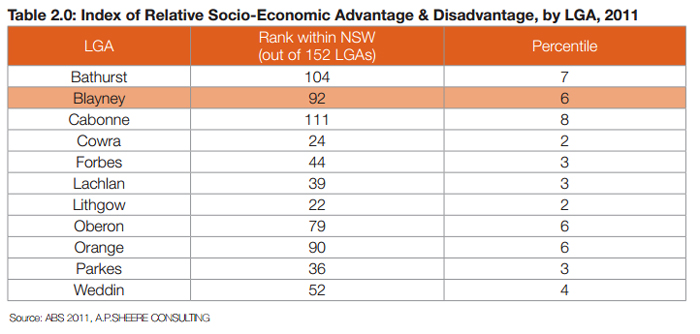SEIFA Data
What is the SEIFA index?
The Socio-Economic Indices for Areas (SEIFA) Index of Advantage/Disadvantage is published by the ABS. The SEIFA index takes into account and summarises high values (advantages) and low values (disadvantages) taken from Census variables such as households with low income (disadvantage) and people with a tertiary education (advantage).
What does the SEIFA Index tell us?
SEIFA data helps to identify workforce skills, social issues and potential skills development within a region.
What do the scores/ranks mean?
A lower rank indicates that an area is relatively disadvantaged compared to an area with a higher rank. All areas are ordered from the lowest to highest rank - the lowest rank being 1 - and placed in deciles ranging from 1 to 10 with 1 being the lowest decile of advantage/disadvantage. The area with the highest rank of 152 (having the highest level of advantage) would be placed in the 10th decile of advantage/disadvantage.
What is Blayney’s SEIFA ranking and what does it mean?
The SEIFA index placed the Blayney Government Area in the 6th decile of advantage and disadvantage, that is, amongst the most relative advantaged Local Government Areas in NSW. This means that the number of households possessing ‘advantage’ variables is marginally greater than the number of households benefiting from ‘disadvantage’ variables. Blayney in fact had the 92nd ranking of all Local Government Areas in NSW meaning that there were 60 other Local Government Areas that had a higher advantage index than Blayney.

Bathurst and Cabonne have the highest SEIFA rankings amongst the LGAs listed above, followed by Blayney, Oberon and Orange which share the same percentile ranking. These are socio-economically more advantaged than the other LGAs listed. These results are attributable to some extent to a relatively higher proportion of their respective resident population being tertiary quali!ed and other economic and social factors.
What opportunities does the SEIFA ranking present?
The comparatively high ranking potentially indicates a higher level of disposable income resulting from employment status and a greater opportunity for businesses to capture this income locally. Opportunities exist to fully identify gaps in retail provision, services, entertainment and leisure services to further capture the local retail expenditure.
Blayney’s ranking also indicates that the resident population is predominantly well educated providing a local workforce for established and new businesses looking to relocate. This also provides a potential employment pool of highly skilled individuals that might not be found in other neighbouring regions. This is supported by Census Education data illustrated in Table 2.1 below which shows that Blayney has a comparatively high percentage of residents who are tertiary educated.

The Industry and Investment NSW Regional Business Growth Plan for Central West NSW identifies ‘Skills and Employment’ as a key opportunity and challenge for the Region. The Strategy identifies the retention of professional and technical skills, retention and attraction of trade apprentices, ageing workforce and skill shortages as key strategic challenges for the Region. The Department views opportunities in the skills development area to be focussed around:
- Health (with Charles Sturt University) and green skills (with the Flannery Centre and TAFE NSW); and
- Green skills in traditional trade areas (e.g. building and construction, electrical, plumbing and refrigeration).
Last modified:
29 Sep 2014